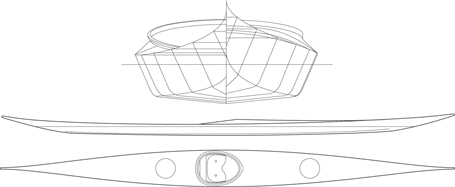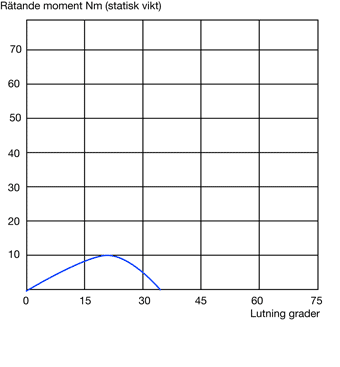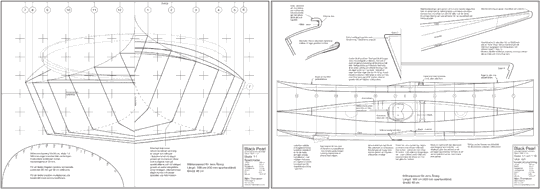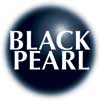Black Pearl
Latest updated Friday, October 25, 2024, 143 comments
Images | Particulars | More about | Background and history
Plans, Black Pearl - 230 EUR
Purchase
Black Pearl is a long, low and narrow kayak of east Greenland ancestry – extremely easily handled, instantly reacting to shift of weight, leaning etc, and with enough secondary stability to support leaned turns, balance braces and such. It is very easily rolled. The initial stability is low but with the reassuring secondary stability it is not out of reach even for a novice (at least one with some patience and perseverance). Wetted surface and drag is very low, which together with light weight gives splendid acceleration – a couple of strokes to top speed. In spite of its maneuverability Black Pearl has good directional stability and is not noticeably affected by wind. Room for gear is minimal – it takes more than a little ingenuity for extended touring in Black Pearl.
Like the original, the kayak is built to fit the owner. When you order the plans I will ask for your length, weight, arm span, hip width and shoe size to produce a custom set of plans perfectly suited to you. That is why Black Pearl is a little more expensive than my other designs.
Black Pearl is designed on the Hunter hull – but smaller. Where Hunter is a compromise - some touring, some play – Black Pearl is a 100% play and roll kayak.
Visual qualities are important – I spend a lot of time tweaking lines and surfaces into a harmonious blend. Jay Babina, American artist and designer (Outer Island Kayaks), wrote on the Qajaqusa forum after having seen and tried the Black Pearl
"There's a lot of nice looking kayaks out there and there's some nice paddling kayaks, but this boat is truly a real beautiful kayak in many ways. What make a kayak really outstanding is the subtilities that add up to an overall effect or visual statement. The overhang of the bow and gentle curve of the stern and even the way the skeg is molded is truly a nice piece of art work and has an overall sensability of design and proportions. This is truly a great looking design which includes the craftsmanship on Scott's particular boat as well. It's my first time seeing it live and I was quite impressed. How it paddles – that's up to you."
Jay Babina
And from John March:
"One of these days, I'll get around to putting up a review, but as the paddler of the second BP Dan built, I just want to say that it not only looks beautiful, it paddles beautifully. Until the BP, I paddled a Pintail in surf, so that is my reference point. I have never been in a more reassuring boat than the BP in lumpy water. Way more fun than the Pintail. Whatever I wanted it to do, the BP did with grace and relatively little effort. It isn't stability but responsiveness that is remarkable. Even after I blew off the aft Beckson hatch when dumped on by a six foot wave and had some water sloshing around back there, it still paddled reasonably well. And did I mention all the compliments – "looks like it belongs in MOMA" etc...."
John March
*Update: John´s review!
Jan Sörfeldt is building a light Black Pearl in Paulownia – photos and text (in Swedish).
 There is also a Facebook group: Black Pearl, started by Annie Juhl in Denmark a couple of years ago – lots of nice photos, reviews, discussions, building tips and more...
There is also a Facebook group: Black Pearl, started by Annie Juhl in Denmark a couple of years ago – lots of nice photos, reviews, discussions, building tips and more...
The Pearl is generally easy to build, with flat panels between chines, flat aft deck and gently curved foredeck, simple deck plates instead of elaborate wooden hatches and a limited amount of deck hardware – and most builders finish under 100 hours. Black Pearl plans have also been used as a starting point for at least two traditional SOF:s, one Tom Yost-folder and one S&G kayak – conversions that are easy to do, though not described on the plans.
 The Pearl is the kayak that has triggered the most interesting experiments in coloring schemes and decoration, as seen in the builder photos below – or in Dan Perry's video.
The Pearl is the kayak that has triggered the most interesting experiments in coloring schemes and decoration, as seen in the builder photos below – or in Dan Perry's video.
Here is a video where Swedish Björn Welin paddle and roll his BP on a windy day.
Graham Wintersgill performs a couple of handrolls.
Particulars

| Length¹ |
550/460 cm (overall/WL) |
| Beam |
49/47 cm (overall/WL) |
| Draft |
10 cm |
| Cockpit¹ |
50x39 cm |
| Height¹ |
23/13 cm (in front of/behind the cockpit) |
| Weight² |
13-17 kg |
| Displacement/volume⁶ |
100 kg/200 litre |
| Speed³ |
8.1/11.2 km/h |
| Prismatic coefficient |
0.54 |
| Wetted surface |
1.69 m² |
| Drag⁴ |
1.48/3.07 kp |
| Stability⁵ |
1/2 (initial/secondary stability) |
| Intended use |
Rolling and advanced paddling. Day tours and exercise. |
* These dimensions can be adapted to suit personal needs or wishes.
** Depending on type of wood, equipment, care with epoxy usage, sanding etc. etc.
*** The speed numbers are based on mathematical standard formulas (175 lb paddler + 30 lb carco weight) and corrected from the kayaks actual performance om trials, on tours and in races.
⁴ Calculated resistance in 4 and 5 knots (at nominal load capacity).
⁵ Initial stability and secondary stability on a subjective scale, where 1 is very tippy and 5 is very stable.
⁶ Displacement is kayak + paddler + load. Count off the kayak weight to get the load capacity.

Stability
The curve shows the calculated stability with a static load, and therefore of limited use for a real paddler. The part of the curve near zero degrees indicates the initial (primary) stability – the steeper the curve, the more stable. The part of the curve left of the peak indicates end (secondary) stability – the higher and wider, the safer you feel edging the kayak. The position of the peak shows also how much the kayak can be leaned without tipping over. The part of the curve to the right of the peak with rapidly decreasing righting moment is almost impossible to take advantage of.
Plans
The plan sheets contain the information needed to build the kayak/canoe. Station molds, stems and construction details are full scale. For kayaks the recommended cockpit size is shown half scale with offsets for a full scale drawing and advice on altering the size. On the plans you will also find advice on how to shorten or lengthen the craft. Lines and construction drawings are in metric scale 1:10.

 The illustrated step-by-step building manual is in Swedish only, but it is available online in English: it covers all steps in detail and will guide first-time builders through the project.
The illustrated step-by-step building manual is in Swedish only, but it is available online in English: it covers all steps in detail and will guide first-time builders through the project.
Plans, Black Pearl - 230 EUR
Purchase
More on Black Pearl
Black Pearl is based on the east Greenland kayaks from the late 20th century - narrower, lower, with more overhangs and a straighter sheer, less deadrise and more flare than the western types. These were overall faster (particularly against the wind) and maneuvered better. With less initial stability it was a demanding craft. In eastern Greenland, seals were hunted from kayaks until a couple of decades ago and the tradition is unbroken.
My take on this is a kayak lacking most characteristic qualities – meaning a kayak that is not stable nor unstable, not directionally stable nor maneuverable, not fast nor slow - but a kayak subtly following the paddler's intentions. No "kayak feel" between the paddler and the sea, no built in safety margin that saves the erring paddler and little mass to compromise fast maneuvering – a very reliable kayak.
Black Pearl is long, following Greenlandic tradition with length three times the height of the paddler. The waterline length is relatively short with sloping stems – resulting in good maneuverability at low speeds and good directional stability at higher speeds when bow and stern waves climb the stems. Top speed is good for a Greenland kayak but does not match the full-ended archipelago kayaks like Nomad or Njord.
 The narrow waterline means a tippy kayak. The total beam is hip width plus approx six fingers for a rolling/touring kayak: approximatively 46-52 cm. My own Black Pearl is 559 cm x 48 cm and 21,5 cm high in front of the cockpit (I am 185 cm tall, weigh 80 kg and wear size 43/US9.5 shoes). Because of the narrow beam, initial stability is low and a novice or someone used to wide commercial kayaks will have a nervous first trip. But with a good secondary it is easy to get used to the movements – and in waves, there is a pleasant surprise: waves do not affect a 'tippy' kayak as much as a 'stable' one. When surfing, Black Pearl settles in its own wave system and becomes surprisingly stable and easily handled.
The narrow waterline means a tippy kayak. The total beam is hip width plus approx six fingers for a rolling/touring kayak: approximatively 46-52 cm. My own Black Pearl is 559 cm x 48 cm and 21,5 cm high in front of the cockpit (I am 185 cm tall, weigh 80 kg and wear size 43/US9.5 shoes). Because of the narrow beam, initial stability is low and a novice or someone used to wide commercial kayaks will have a nervous first trip. But with a good secondary it is easy to get used to the movements – and in waves, there is a pleasant surprise: waves do not affect a 'tippy' kayak as much as a 'stable' one. When surfing, Black Pearl settles in its own wave system and becomes surprisingly stable and easily handled.
Black Pearl maneuvers superbly. The almost flat bottom (5° deadrise), the hard chines and the short waterline length means that the kayak is easy to turn and reacts instantly to leans and weight shifts. The low deck takes some getting used to, but after a while, there are some benefits – the comfort of needing no firm support padding against the knees, hips, back etc and working with the knees as an additional power source for the strokes.
The deck aft is very low and flat to facilitate layback rolls.
When choosing Black Pearl you should be a reasonably experienced paddler and interested in developing skills in rolling, kayak acrobatics, exploring rock gardens, day touring etc. An ambitious novice with patience and perseverance might use Black Pearl as a crash course to advanced paddling.
Black Pearl - background and history
The east Greenland kayak found its form later than the west Greenland types, but late in the 20th century, it began to gain popularity around the coast. Compared to older types it was narrower, lower, with more overhangs and a straighter sheer, less deadrise, and more flare. It was overall faster (particularly against the wind) and it maneuvered better. With less initial stability it was a demanding craft. In eastern Greenland, seal was hunted from kayak until a couple of decades ago and the tradition is unbroken.

Black Pearl, designed in 2003, is loosely based on the east Greenland kayaks, mainly the one depicted in the American Museum of Natural History (fig 208 i "the Bark Canoes and Skin Boats of North America"). While not a replica – strip instead of SOF for a start – I have strived for an overall feel in handling that is close to the original.
I painted the prototype black – a change from my usual bright-finished kayaks – for three reasons: the contemporary Greenland kayaks used for rolling contests sometimes are black, when building I saw the little Japanese carbon fiber kayak Qaanaaq and I wanted to accentuate the small size of the kayak (dark colors makes things look smaller). An amusing coincidence was that one week after my first trial tour Bill Withcomb launched his plywood kayak, with almost the same dimensions, also painted black. We even published photos (both unaware of the other) of our kayaks with black pets in the cockpit: a black cat in mine and Bill´s dark-colored dog in his.

